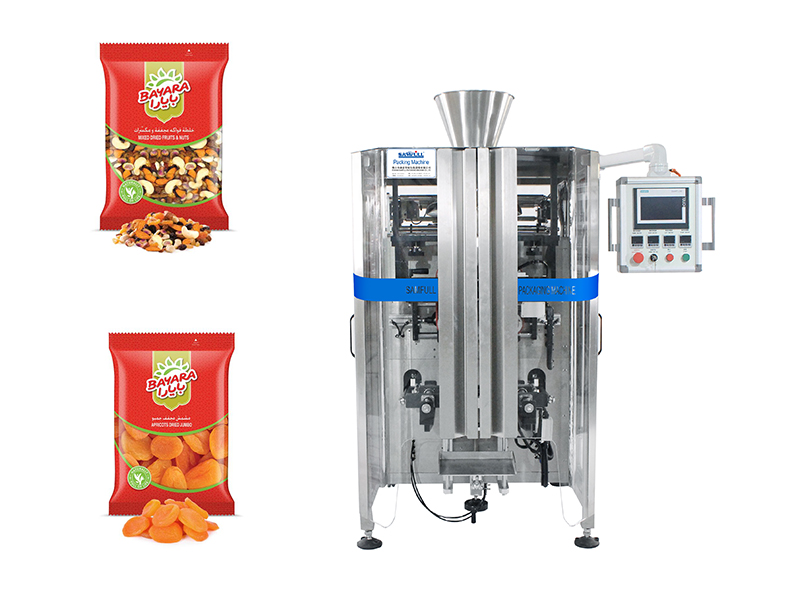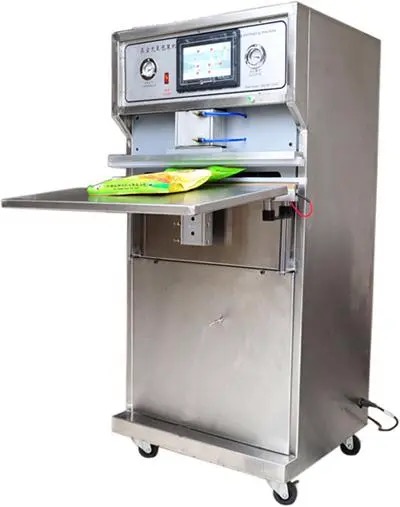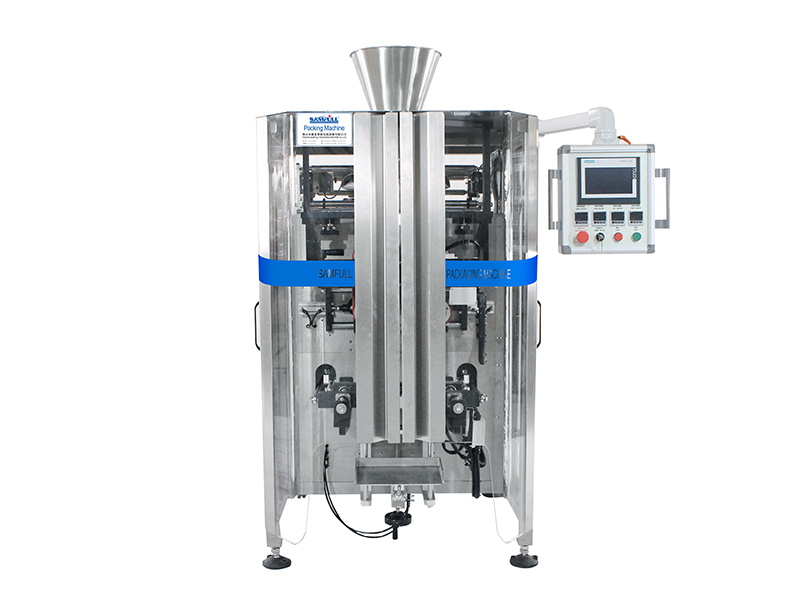
Content Menu
● Introduction to Dry Food Packaging Machines
● The Importance of Dry Food Packaging Machines in Modern Food Production
>> Key Benefits of Dry Food Packaging Machines
● Types of Dry Food Packaging Machines
>> 1. Vertical Form Fill Seal (VFFS) Machines
>> 2. Horizontal Form Fill Seal (HFFS) Machines
>> 3. Premade Pouch Packaging Machines
>> 4. Multi-head Weighing Machines
● Choosing the Right Dry Food Packaging Machine for Your Business
>> 1. Production Volume
>> 2. Product Characteristics
>> 3. Packaging Material
>> 4. Flexibility and Changeover
>> 5. Integration with Existing Systems
>> 6. Maintenance and Support
● Latest Innovations in Dry Food Packaging Machines
>> 1. Smart Packaging Solutions
>> 2. Sustainable Packaging Options
>> 3. Advanced Sealing Technologies
>> 4. Modular and Customizable Designs
● The Impact of Automation on Dry Food Packaging
>> 1. Increased Productivity
>> 2. Enhanced Accuracy and Consistency
>> 3. Data Collection and Analysis
>> 4. Reduced Labor Costs
● Maintaining Your Dry Food Packaging Machine
>> 1. Regular Cleaning
>> 2. Scheduled Inspections
>> 3. Lubrication
>> 4. Software Updates
>> 5. Operator Training
● The Future of Dry Food Packaging Machines
>> 1. Integration of Artificial Intelligence
>> 2. Enhanced Sustainability Features
>> 3. Increased Customization Capabilities
>> 4. Internet of Things (IoT) Integration
● Conclusion
● Frequently Asked Questions
>> 1. What types of dry foods can be packaged using these machines?
>> 2. How do I determine the right packaging machine size for my business?
>> 3. Can dry food packaging machines handle different package sizes?
>> 4. What are the energy requirements for dry food packaging machines?
>> 5. How often should maintenance be performed on a dry food packaging machine?
Introduction to Dry Food Packaging Machines
In today's fast-paced food industry, efficiency and quality are paramount. Dry food packaging machines have emerged as a game-changing solution for businesses looking to streamline their packaging processes and meet the growing demand for packaged dry foods. These innovative machines are designed to handle a wide range of dry food products, from grains and nuts to dried fruits and snacks, ensuring that each item is packaged precisely and hygienically.
The Importance of Dry Food Packaging Machines in Modern Food Production
As consumer preferences shift towards convenience and longer shelf life, the demand for packaged dry foods has skyrocketed. This trend has made dry food packaging machines an indispensable asset for food manufacturers of all sizes. These machines not only increase production efficiency but also maintain product quality and extend shelf life, making them a crucial investment for businesses looking to stay competitive in the market.
Key Benefits of Dry Food Packaging Machines
1. Increased Production Speed: Automated packaging machines can significantly boost output, allowing businesses to meet higher demand.
2. Improved Hygiene: By minimizing human contact, these machines reduce the risk of contamination.
3. Consistency: Automated systems ensure uniform packaging, weight, and sealing across all products.
4. Cost-Effectiveness: While the initial investment may be substantial, the long-term savings in labor and increased efficiency make these machines highly cost-effective.
5. Versatility: Modern machines can handle various packaging materials and product types, offering flexibility to manufacturers.

Types of Dry Food Packaging Machines
The market offers a diverse range of dry food packaging machines, each designed to cater to specific packaging needs and production volumes. Understanding the different types available can help businesses choose the right machine for their operations.
1. Vertical Form Fill Seal (VFFS) Machines
VFFS machines are among the most popular choices for dry food packaging. These versatile machines form bags from a flat roll of film, fill them with product, and seal them in a continuous process. They are ideal for packaging a wide range of dry foods, including nuts, grains, and snacks.
2. Horizontal Form Fill Seal (HFFS) Machines
HFFS machines are particularly suited for products that require gentle handling or have a flat profile. They are commonly used for packaging crackers, cookies, and other delicate dry foods. These machines form the package horizontally, fill it with the product, and seal it in a single, smooth operation.
3. Premade Pouch Packaging Machines
For businesses looking for flexibility in packaging design, premade pouch packaging machines are an excellent choice. These machines work with pre-formed pouches, filling and sealing them with precision. They are ideal for packaging dried fruits, trail mixes, and specialty dry food products.
4. Multi-head Weighing Machines
Often used in conjunction with other packaging machines, multi-head weighers ensure accurate portioning of dry food products before packaging. These machines are crucial for maintaining consistency in package weight and content.
Choosing the Right Dry Food Packaging Machine for Your Business
Selecting the appropriate dry food packaging machine is a critical decision that can significantly impact your business's efficiency and profitability. Here are some key factors to consider:
1. Production Volume
Assess your current production needs and future growth projections. Machines come in various capacities, from small-scale units producing a few packages per minute to high-speed systems capable of hundreds of packages per minute.
2. Product Characteristics
Consider the nature of your dry food products. Factors such as size, shape, and fragility will influence the type of machine that's best suited for your needs. For instance, delicate items may require gentler handling systems.
3. Packaging Material
Different machines are designed to work with specific packaging materials. Ensure that the machine you choose is compatible with your preferred packaging type, whether it's plastic films, paper, or biodegradable materials.
4. Flexibility and Changeover
If you produce a variety of products, look for machines that offer quick and easy changeovers between different package sizes or product types. This flexibility can save significant time and reduce downtime between production runs.
5. Integration with Existing Systems
Consider how the new packaging machine will integrate with your current production line. Look for machines that can easily connect with your existing equipment and software systems for seamless operation.
6. Maintenance and Support
Opt for machines from reputable manufacturers that offer robust after-sales support, including maintenance services and readily available spare parts. This ensures minimal downtime and longevity of your investment.

Latest Innovations in Dry Food Packaging Machines
The field of dry food packaging is constantly evolving, with new technologies emerging to meet the changing needs of the industry. Here are some of the latest innovations:
1. Smart Packaging Solutions
Modern dry food packaging machines are increasingly incorporating smart technologies. These include integrated sensors that monitor packaging integrity, product freshness, and even track the package throughout the supply chain. Such innovations not only improve quality control but also enhance traceability and consumer trust.
2. Sustainable Packaging Options
With growing environmental concerns, many dry food packaging machines now offer options for using eco-friendly packaging materials. These machines are designed to work efficiently with biodegradable films, recyclable plastics, and paper-based packaging, helping businesses reduce their environmental footprint.
3. Advanced Sealing Technologies
Innovations in sealing technologies have led to more secure and durable packaging. Ultrasonic sealing, for instance, offers stronger seals without the need for heat, making it ideal for heat-sensitive dry foods. These advancements ensure better product protection and extended shelf life.
4. Modular and Customizable Designs
The latest dry food packaging machines often feature modular designs, allowing for easy customization and upgrades. This flexibility enables businesses to adapt their packaging capabilities as their needs evolve, without the need for complete system overhauls.
The Impact of Automation on Dry Food Packaging
Automation has revolutionized the dry food packaging industry, bringing about significant improvements in efficiency, consistency, and quality control. Here's how automation is shaping the future of dry food packaging:
1. Increased Productivity
Automated dry food packaging machines can operate continuously, significantly increasing production output. Many modern systems can run 24/7 with minimal human intervention, leading to substantial increases in productivity.
2. Enhanced Accuracy and Consistency
Automated systems eliminate human error in measuring and packaging, ensuring consistent product weight and packaging quality. This precision not only improves product quality but also helps in regulatory compliance and customer satisfaction.
3. Data Collection and Analysis
Modern packaging machines are equipped with sensors and data collection systems that provide valuable insights into the packaging process. This data can be used to optimize operations, predict maintenance needs, and improve overall efficiency.
4. Reduced Labor Costs
While automated systems require an initial investment, they can significantly reduce labor costs in the long run. This is particularly beneficial for businesses dealing with labor shortages or looking to reallocate human resources to more value-added tasks.
Maintaining Your Dry Food Packaging Machine
Proper maintenance is crucial for ensuring the longevity and optimal performance of your dry food packaging machine. Here are some key maintenance tips:
1. Regular Cleaning
Establish a rigorous cleaning schedule to prevent product buildup and contamination. Pay special attention to areas that come into direct contact with food products.
2. Scheduled Inspections
Conduct regular inspections of all machine components, including sealing mechanisms, conveyor belts, and electrical systems. Early detection of wear and tear can prevent costly breakdowns.
3. Lubrication
Keep all moving parts properly lubricated according to the manufacturer's recommendations. This reduces friction and extends the life of mechanical components.
4. Software Updates
For machines with digital controls, ensure that software is regularly updated to benefit from the latest features and security patches.
5. Operator Training
Invest in comprehensive training for machine operators. Well-trained staff can identify potential issues early and operate the machine more efficiently.
The Future of Dry Food Packaging Machines
As we look to the future, the dry food packaging machine industry is poised for further innovation and growth. Here are some trends to watch:
1. Integration of Artificial Intelligence
AI-powered systems are expected to play a larger role in optimizing packaging processes, predicting maintenance needs, and ensuring quality control.
2. Enhanced Sustainability Features
Future machines are likely to place even greater emphasis on sustainability, with designs that minimize waste, reduce energy consumption, and work seamlessly with eco-friendly packaging materials.
3. Increased Customization Capabilities
As consumer demand for personalized products grows, packaging machines may evolve to offer greater flexibility in package design and on-demand customization.
4. Internet of Things (IoT) Integration
IoT technology will enable better connectivity between packaging machines and other production systems, leading to more streamlined and efficient operations.
Conclusion
Dry food packaging machines have become an integral part of the modern food industry, offering numerous benefits in terms of efficiency, quality, and consistency. As technology continues to advance, these machines will play an even more crucial role in meeting the evolving demands of consumers and businesses alike. Whether you're a small startup or a large-scale food manufacturer, investing in the right dry food packaging machine can significantly enhance your production capabilities and give you a competitive edge in the market.

Frequently Asked Questions
1. What types of dry foods can be packaged using these machines?
Dry food packaging machines can handle a wide variety of products, including grains, nuts, dried fruits, snacks, cereals, powders, and even pet food. The versatility of these machines makes them suitable for packaging almost any dry food product.
2. How do I determine the right packaging machine size for my business?
To determine the right size, consider your current production volume, future growth projections, available space, and budget. It's often advisable to choose a machine with slightly higher capacity than your current needs to accommodate future growth.
3. Can dry food packaging machines handle different package sizes?
Many modern dry food packaging machines are designed with flexibility in mind and can handle various package sizes. However, the range of sizes a machine can accommodate will depend on its specific design and capabilities. Always check the machine specifications or consult with the manufacturer to ensure it meets your packaging size requirements.
4. What are the energy requirements for dry food packaging machines?
Energy requirements vary depending on the size and type of the machine. Smaller machines may operate on standard electrical outlets, while larger industrial machines might require three-phase power. It's important to check the power specifications of the machine and ensure your facility can meet these requirements.
5. How often should maintenance be performed on a dry food packaging machine?
The frequency of maintenance depends on factors such as usage, environment, and the specific machine model. Generally, daily cleaning, weekly inspections, and monthly more thorough maintenance checks are recommended. However, always refer to the manufacturer's guidelines for specific maintenance schedules and procedures.












